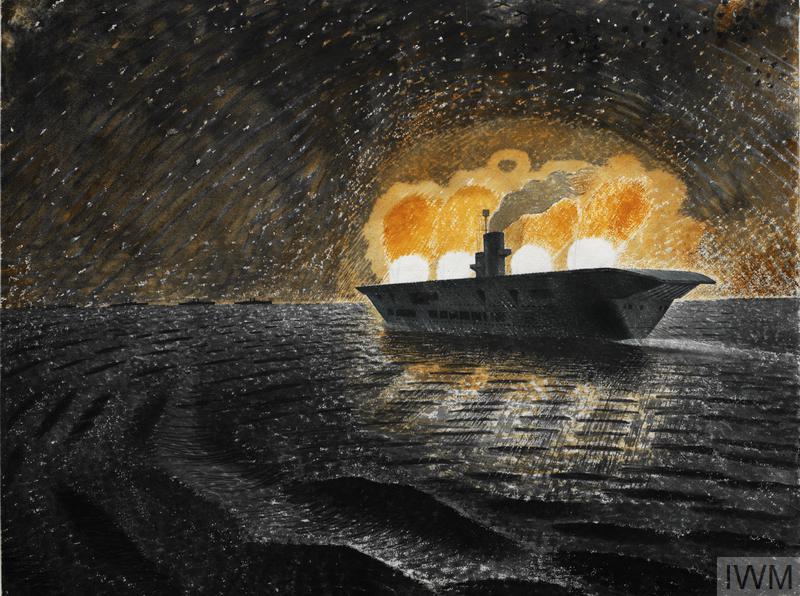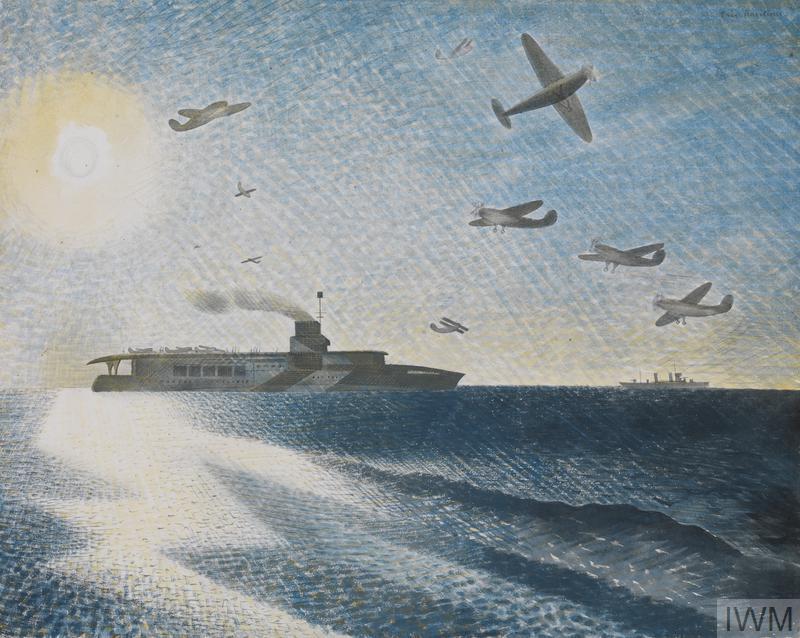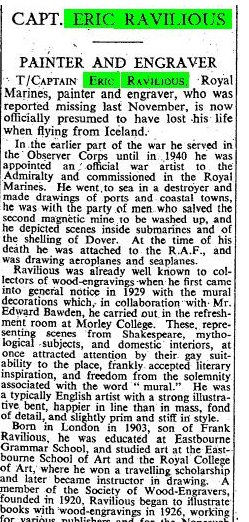Artists at War: Eric Ravilious
On the 75th anniversary of his death we take a look at Eric Ravilious’s work as a war artist.
Eric Ravilious* was born in Acton in 1908 and the family later moved to Eastbourne where he studied at the art school. Ravilious moved to London to study at the Royal College of Art in the Design School, under Paul Nash. He later returned to Eastbourne where he taught at the art school which was where he met his future wife Tirzah Garwood
Ravilious greatly loved the chalk down lands of Sussex, often depicting the chalk of the downs by leaving the white of the paper unpainted. His main medium was watercolours- he had experimented with oils but found that they did not suit him. Ravilious was adept at using cross-hatching, scratching and depicting textures in watercolour. He was also an accomplished wood engraver often using the medium for his commercial work, and he also produced designs for ceramics, notably for Wedgwood.
When the Second World War was declared Ravilious was living in Castle Hedingham in Essex. He immediately signed up for a part-time post monitoring German aircraft on behalf of the Royal Observer Corp. However, by Christmas Eve he had received a letter from the War Artists’ Advisory Committee (WAAC) saying that he had been selected to work for the Ministry of Information and was to begin on Admiralty subjects as part of the war artists’ scheme. After two interviews he was then given a six month contract and a fee of £325 pounds and in return he was to hand over every piece of work that he produced during that time. He was given the honorary rank of a captain in the Royal Marines and on 10 February 1940 he officially began work after having been vetted by M15.
He was posted to Nore Command (this command covered the coast from north Kent to Flamborough Head) and worked at Chatham, Sheerness and Grimsby and in April he sailed to Norway on board HMS Highlander.

HMS Highlander was part of an expeditionary force that was sailing from Scapa Flow to Norway, headed by the aircraft carriers Glorious and Ark Royal (Ravilious painted Ark Royal and Glorious see images 1 and 3) ) whose purpose was to capture the Norwegian port of Narvik. (The air and sea battle for the port of Narvik was part of the Norwegian Campaign which lasted until early June 1940). He enjoyed being on board and the effect of the sunlight on the sea, being away miles from land, the stark beauty of Norway, and hours of light as midsummer approached. He impressed the sailors with his ability to sketch on deck even when guns were being fired and enemy aircraft were overhead. In contrast, he found the time he spent on board submarines uncomfortably claustrophobic and hot but nonetheless productive as he used his sketches as a basis for a series of lithographs.
Ravlious’s work was exhibited, alongside that of other war artists, at the National Gallery in July 1940, and met with praise from officials and the public.
In July he left Nore Command and drew submarine interiors at Gosport and then coastal defences at Newhaven. His six month contract ended in August 1940 and he returned home to Essex. In November he was given another six month contract and other contracts followed. Being under contract gave Ravilious the luxury, unknown before the war, of being able to earn a good salary and to concentrate on painting
From July 1941 he was at Dover painting mainly coastal defences, and from there he went to Dunfermline, and then to a Fleet Air Arm station at Dundee where he painted flying boats. In 1942 he began working for the Air Ministry and developed a love of planes, though not bombers, and was posted to various RAF bases. In February he was at RAF Clifton, just outside York, but had to return home as Tirzah, who had breast cancer, was to have a mastectomy. While in Somerset, at RAF Western Zoyland, he witnessed a seaplane crash, which disturbed him as training carried on regardless. It was almost a premonition.

Ravilious was very keen to go to Iceland, and he asked Tirzah, who was now out of hospital, if he should go. Tirzah knowing how much it mattered to him encouraged him and he flew to Iceland on 28 August 1942. Ravilious planned to stay at Kaldadarnes, on the southern coast, until Christmas. The weather was cold with heavy rain and strong winds and at dawn on 2 September three Hudson aircraft were send on an air sea rescue mission with Ravilious on board. The plane Ravilious was on never returned and the only wreckage that was found was a wheel that was washed ashore. In the last letter he wrote home on 31 August he talked about what he planned to see including Greenland and the Icelandic Geysers. On 5 September an Admiralty official wrote to Tirzah to tell her that her husband was missing. This began a terrible period for Tirzah, who was recovering from surgery, had three young children to bring up, and had to deal with the authorities who were unsympathetic. (The situation wasn’t helped as it was only on 2 September that the WAAC were informed of Ravilious’s whereabouts). By January 1943 Tirzah had still not received all of his personnel effects, his outstanding expenses or payment for his work from the WAAC.

Ravilious’s death, while serving as a war artist, threw up the issue of the status of war artists. The view was taken that because artists were given an honorary position in the forces – without pay as they were paid by WAAC – that there was no pension payable either. Effectively, the artists were treated as if they were civilians. This issue of compensation if an artist was killed had been raised by Barnett Freedman in 1940 with WAAC but had never been resolved. It is unclear if Tirzah ever received any compensation for Ravilious’s death.
Two other war artists also died but Eric Ravilious was the only salaried war artists who died while under contract and whose body was never recovered. Ravilious’s name appears on the Royal Navy Memorial at Chatham.

Ravilious’s output as a war artists was large. The depiction of air and sea, aeroplanes and ships, seemed to suit his style and technique and his war work is among some of his best. He painted a wide range of subjects including: aircraft being de-iced, barrage balloons, coastal defences, HM Ark Royal in action and one painting of Corporal Steddiford’s mobile pigeon loft.
*the name was of Huguenot origin.
Bibliography and suggested reading
Artists at the Curwen
Bawden, Ravilious and the Artists at Great Bardfield
The England of Eric Ravilious
Eric Ravilious: Imagined Realities
Long Live Great Bardfield: the autobiography of Tirzah Garwood
Ravilious and Co
Ravilious in Picture: the War Paintings
The Sketchbook War
War Paint
WWII:War Pictures by British Artists
Images sources
1 Imperial War Museum – HMS Ark Royal in the Arctic.
2 Imperial War Museum – Painted while Ravilious was at RAF Sawbridgeworth, Hertforshire
3 Imperial War Museum – HMS Glorious in the Arctic.
4 The Times Digital Archive
Related links
Both of these galleries have substantial collections of Eric Ravilious’s work.
Fry Art Gallery
Towner Art Gallery
Library members can access the entries in the Oxford Dictionary of National Biography for the people listed above by clicking on the hyperlinks in the text. The Times Digital Archive is also available to library members. Tirzah Garwood‘s entry in the Oxford Dictionary of National Biography is the 60,000th entry.
[Fiona Campbell, Library Assistant]
